20 Notable Still-Life Artists That You Should Know
- Michelangelo Merisi da Caravaggio (1571 - 1610)
- Ambrosius Bosse the Elder (1573 - 1621)
- Clara Peeters (1594 - 1657)
- Jacob Van Es (1596 - 1666)
- Pieter Claesz (1597 - 1661)
- Francisco de Zurbaran (1598-1664)
- Giovanna Garzoni (1600 - 1670)
- Louise Moillon (1610 - 1696)
- Gerrit Do, Also Known As Gerard Do (1613 - 1675)
- Willem van Aelst (1627 - 1683)
- Adriaen van der Spelt (1630 - 1673)
- Rachel Ruysch (1664 - 1750)
- Jean-Baptiste-Simeon Chardin (1699 - 1779)
- Luis Melendez (1716 - 1780)
- Francisco Goya (1746 - 1828)
- Sarah Miriam Peale (1860-1885)
- Gustave Courbet (1819 - 1877)
- Lilly Martin Spencer (1822 - 1900)
- Henri Fantin Latour (1836 - 1904)
- Paul Cezanne (1839 - 1906)
- The Key Takeaways
Artists have been depicting arrangements of still items since very ancient times. On the other hand, still-life paintings did not become a separate genre until the 16th century.
That's when Flemish artists and Dutch painters captured complex compositions of everyday items. These scenes were originally used to symbolize prosperity and infused with religious symbolism. The genre spread to Europe and America and evolved into many different forms.
In this article, let's look at the works of twenty artists who were very successful in this genre of art.
Michelangelo Merisi da Caravaggio (1571 - 1610)
Caravaggio's large-scale religious works and mythological paintings are known for their intense realism and volatile nature. His chiaroscuro technique is also praised. Caravaggio's life was short, but he influenced artists and art movements of the time, including Baroque and Realism. This painting is one of two still-life scenes attributed to Caravaggio (the other is Fruit Basket).
Caravaggio usually uses dramatic contrasts in light, but here, a uniform glow covers the composition, which is populated with a variety of fruits and vegetables. The arrangement conveys a message about life, fertility, and, to some people, even sexual connotations. The artist is said to have painted this scene in his own home, where he made holes in the ceiling for the perfect amount of light.
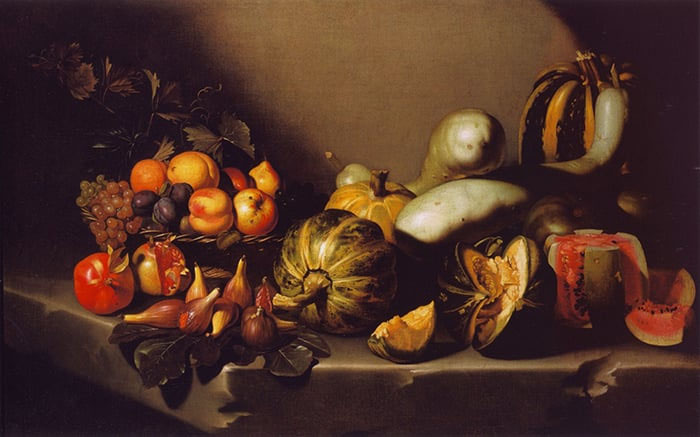
Ambrosius Bosse the Elder (1573 - 1621)
Ambrosius the Elder Bosschaert was one of the Dutch still-life painting pioneers. Ambrosius II Bosschaert, the artist who trained him, was his father.
Ambrosius started his career by capturing rare plants in botanical gardens. He also made drawings for botanist Carolus Clausius. He used his scientific drawings later to create his paintings. After the Spanish troops retook Antwerp, Protestant Bosschaert fled to the Northern Netherlands.
The artist was inspired by a botanical garden while in the Netherlands. This artwork shows the artist's skill in capturing flowers and insects. In a basket, different species of flowers have been arranged. On the table, we are drawn to the pink carnation and white rose. Insects such as bees and butterflies remind us of both the fragility of life and the beauty of nature.
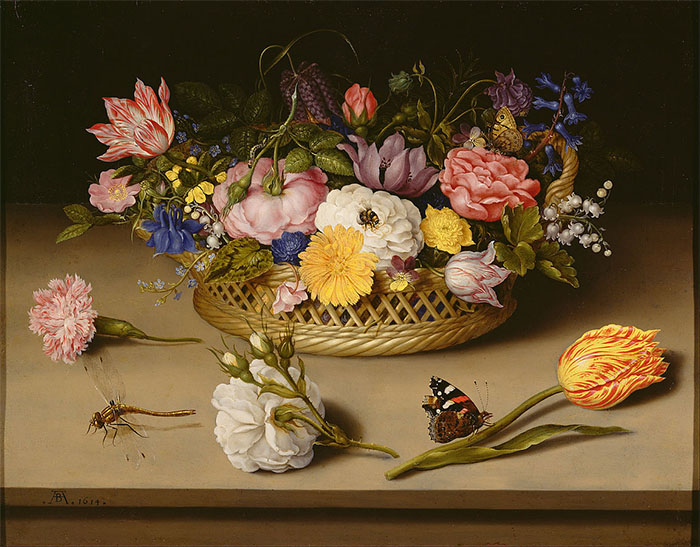
Clara Peeters (1594 - 1657)
Clara Peeters was one of the very few active female painters in Europe during the 17th century. Scholars believe that Clara Peeters was an apprentice of Osias Biert, the famous Antwerp still-life painter. Peeters began painting realistic still-lifes in 1612, often featuring groupings with valuable objects such as metal goblets or gold coins. She also painted rare flowers.
Still Life with Fish and Cat is one of Peeters' most famous works. She depicted an abundance of household items in this work. The different fish scales are stacked on each other, and a cat in the lower right corner holding a fish between its paws stands out. A dim glow dominates the composition. Only a few light accents give the painting a dramatic feel.
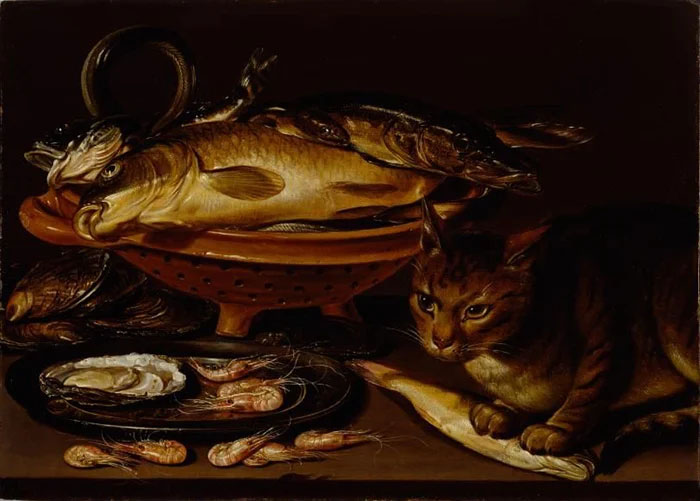
Jacob Van Es (1596 - 1666)
Jacob, along with Clara Peeters or Osias Biert, was one of Flemish painting's first generation. In his long career, Jacob created a number of still-lifes featuring realistic flower or food arrangements.
Van Es is a man whose life has not been well documented. He was most active in Antwerp, achieving Master status in 1617. However, he didn't join the Guild of Saint Luke until much later. His paintings are documented in Antwerp's 17th-century collections, so he must have had some success.
Peter Paul Rubens' inventory included two of his paintings. This still-life scene demonstrates the artist's ability to capture the transparent nature of wine and the textures of the food.
The artist, as was typical in this genre of art, captured the passing of time with a slice of orange and bacon on a platter. The painting has a feeling of abundance and prosperity.
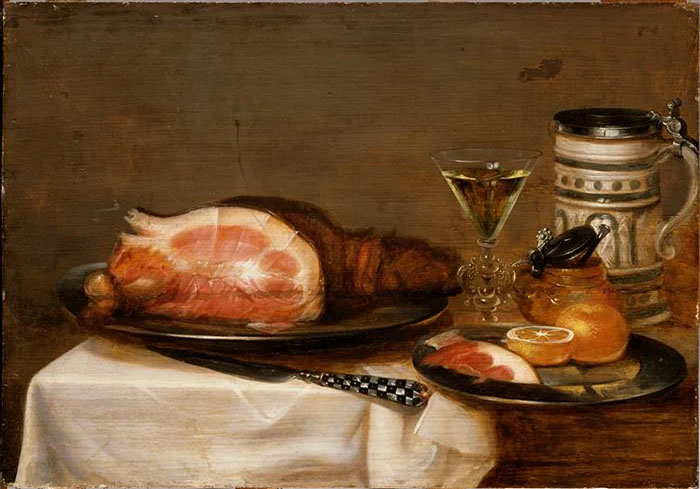
Pieter Claesz (1597 - 1661)
Pieter Claesz is considered one of the greatest still-life artists of all time. The artist's biography remains largely unknown, but his work is often compared to the carefully arranged scenes at Clara Peeters' and Osias Biert the Elder's tables. Claesz painted a wide variety of food, beverages, tobacco products, and musical instruments with extreme realism over the years.
Claesz’s inventive compositions and ability to recombine objects into various original arrangements inspired artists in his hometown and beyond. This lavish table setting is a great example of Claesz's talent. The big turkey pie with a dead bird holding flowers in the background first grabs our attention.
The wine jar is also noticeable, reflecting the window, part of the table, and the blurred figure behind the easel. The half-eaten food represents the passing of time.
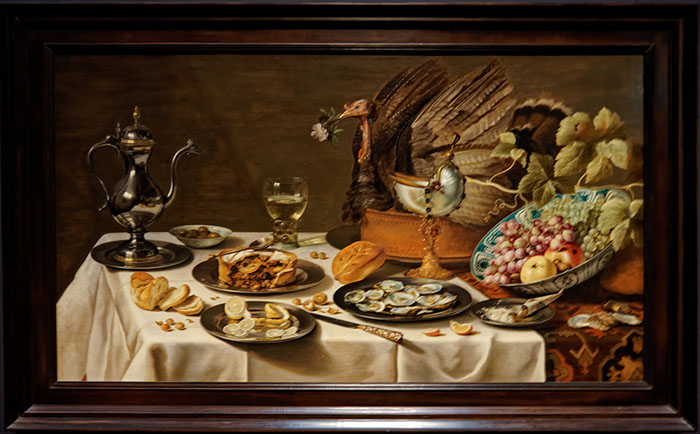
Francisco de Zurbaran (1598-1664)
Zurbaran is famous for his religious paintings and fascinating portrayals. On top of that, he painted still-life pictures. In those paintings, he depicted objects' physical characteristics and surroundings. This Zurbaran painting is his only signed and dated work of still life. It has been described by many as a masterpiece in the genre. The items in this artwork carry profound spiritual symbolism.
For instance, devout Spaniards might have perceived the triad layout as a nod to the Divine Trinity. Additionally, this piece is seen as an homage to the Blessed Virgin, with the oranges, their blossoms, and the water vessel symbolizing her chastity, and the flower without thorns representing her Immaculate Birth. The fruit's textures are depicted with striking realism. The whole setup showcases a harmonious play of light and darkness.
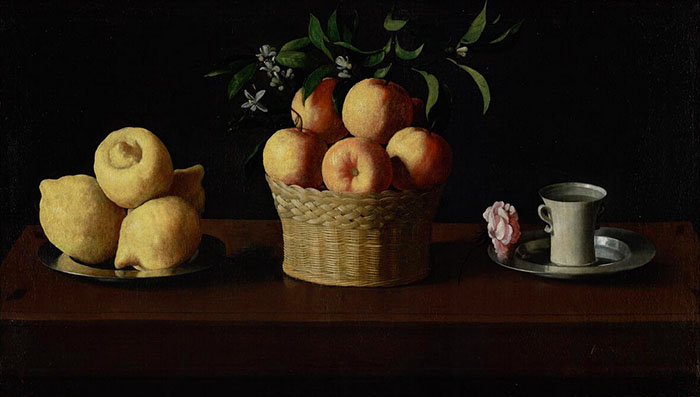
Giovanna Garzoni (1600 - 1670)
Garzoni, an artist from the 17th century known for her botanical illustrations and still-life paintings, showcased exceptional artistic prowess. Having roots in an artistic family and meeting many artists and scientists influenced her. The artist led an unconventional life, as she did not marry and worked at various European courts. She worked for the Medici in Florence for over 25 years. Giovanna's still-life scenes developed a distinct style over time.
She worked with tempera paint on vellum, adding precise dots of color to create realistic compositions. Native flora and exotic fauna were paired together in her work. The artist's ability to draw and paint is evident in this painting. This painting features a hyper-realistic depiction of a basket of citrus fruits picked from a tree. A fly is on one of the fruits, and there are flowers on the table to indicate the passing of time.
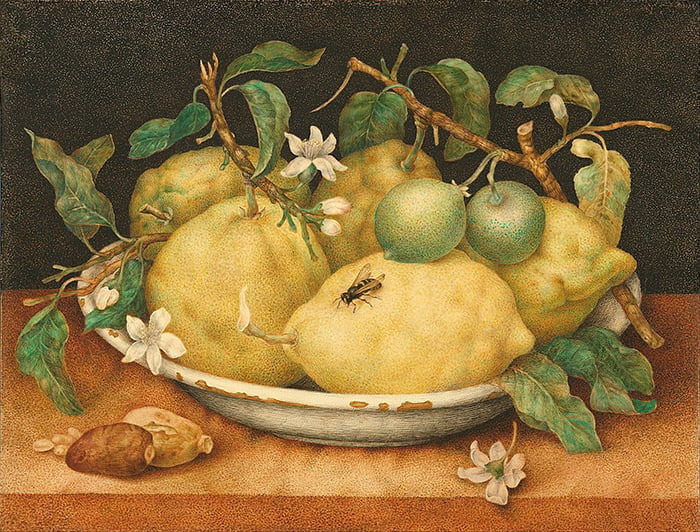
Louise Moillon (1610 - 1696)
Moillon was born into a family of painters and had been exposed to art from a young age. She lived in an area where Protestant refugees were settling from southern Netherlands. Louise was introduced to tabletop still life painting by many of these artists. Moillon, a fellow Protestant, was a leader in this group. He created still-life scenes with fruits and flowers. During her lifetime, art patrons collected and recognized the artist's work.
In 1640, she began a 30-year break from painting to spend more time with her family. In her still-lifes, such as the one shown here, the artist uses a form of illusionism called trompe-l'oeil. Moillon created the illusion of a closer space using devices such as the open, slightly dangling pomegranate. The lemons and oranges have a tactile quality that reinforces the illusion.
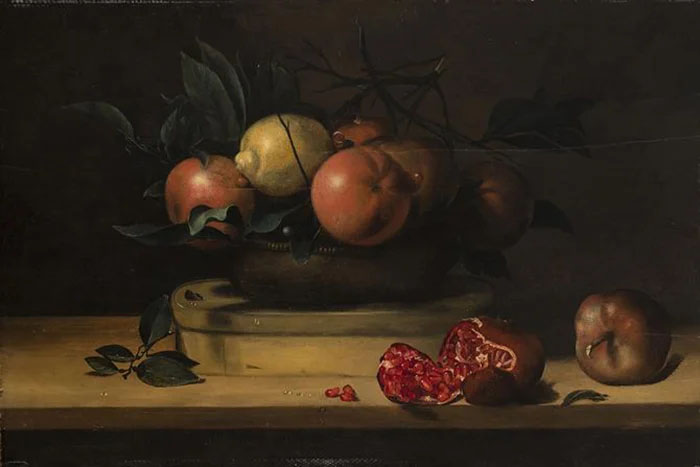
Gerrit Do, Also Known As Gerard Do (1613 - 1675)
Gerrit Dou, the Dutch painter who founded the Leiden Fijnschilderij school, is credited with creating its smooth and small surfaces. He learned engraving from his father, and Rembrandt was one of his students. He specialized over the years in genre scenes. His trompe-l’oeil “niche” works and candlelit scenes heavily using chiaroscuro are his most famous. Dou was an accomplished artist.
His works were, during his lifetime, more expensive than Rembrandt's. His attention to detail is legendary, as he would spend hours on one element in his paintings. This Vanitas shows the artist's ability to reproduce details. This scene contains books, prints, and unfinished paintings.
A skull is also included. In the background of the painting, a convex reflection mirror reflects a domestic setting. Another painting depicting a still-life scene is displayed on the wall beside it. The presence of an actual skull called Memento Mori, a Latin phrase that means "Remember you will die", reminds us about the certainty of death.
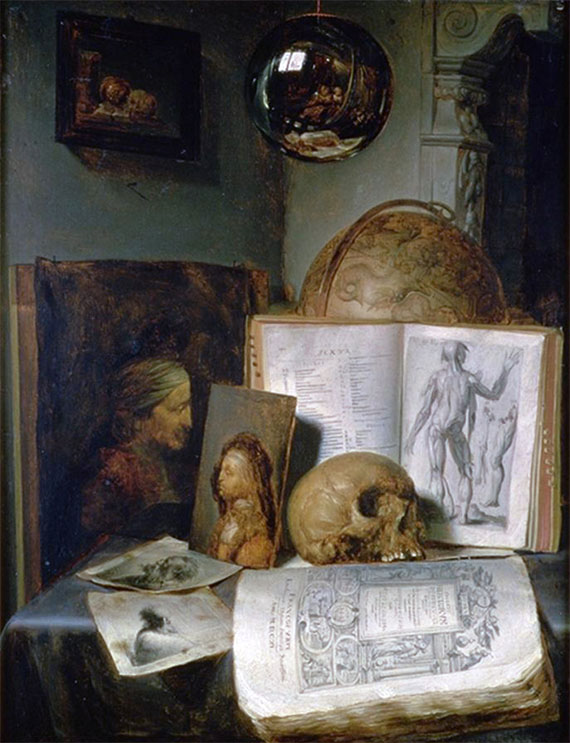
Willem van Aelst (1627 - 1683)
Willem van Aelst (also known as "The Dutchman") spent many years painting still-lifes in Florence. Members of the Medici Family, including Cardinal Leopoldo de' Medici, an avid collector, bought his paintings. He settled in Amsterdam, where he continued to be patronized by notable art patrons.
He painted many types of still-life paintings over the years and was among the first to include hunting trophies in his compositions. This is an excellent example of his hunting still lifestyle. The painting features a dead pigeon, which looks like it was just killed. The composition is dark and gloomy, with a dim light.
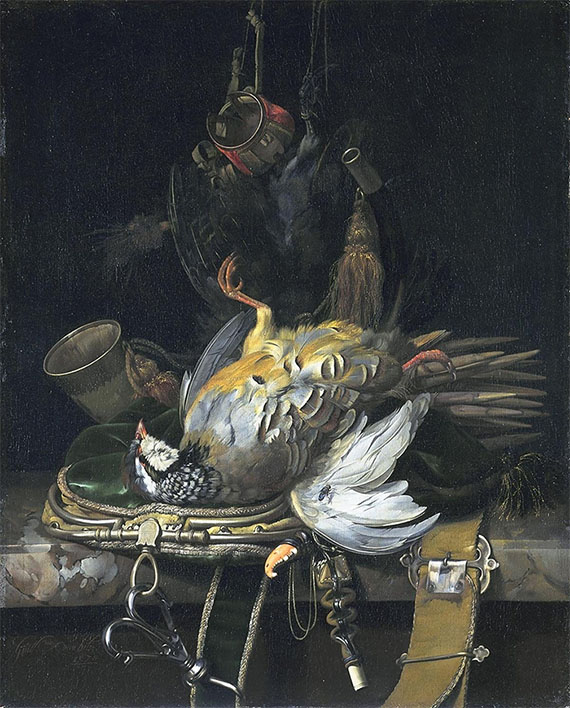
Adriaen van der Spelt (1630 - 1673)
Adriaen van den Spelt's career was marked by still-life paintings where floral arrangements were the focal point. This still-life of a flower garland, which displays 20 different varieties of flowers, is one of his most famous paintings. The artist included a tulip imported from Persia in the 16th century and became an icon of Dutch culture. Although some of the flowers in the background have begun to decay, most of the composition speaks of vitality and life.
An artist's curtain has partially covered this flower arrangement. The blue curtain, which is extremely realistic, refers not only to a common practice of protecting paintings but also to Parhassius' story. Parhassius was a gifted Greek artist who cheated his rival during a painting contest. Parhassius' opponent attempted to pull the painted curtain back!
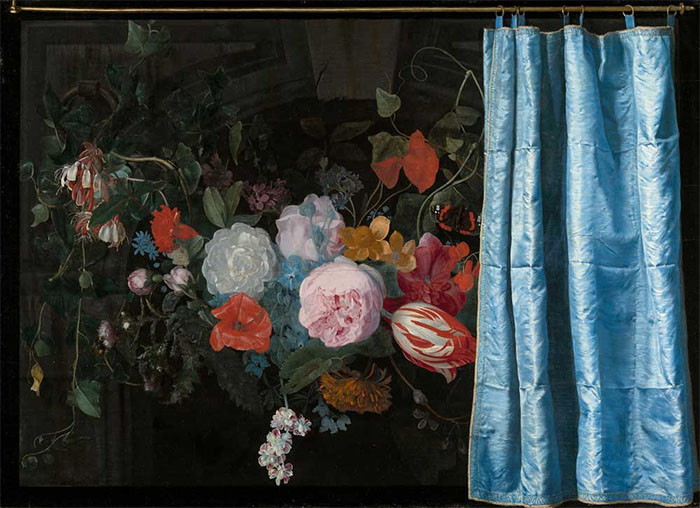
Rachel Ruysch (1664 - 1750)
Rachel Ruysch had a distinguished background. Her father, Frederik Rüysch, was a scientist, and her grandfather, Pieter Post, was an architect. Her father, an artist himself, taught her to portray nature accurately.
At age 15, she became Willem van Aelst's apprentice. She became a member of The Hague of the Painter's Guild and painted flowers for clients from around the world. She lived to be eighty years old, which was unusual for her time.
A group of flowers is the focal point in this still-life. Even the pollen grains can be seen inside the flowers in this pyramidal composition. Scholars doubt that Ruysch intended to use Vanitas in this piece, which emphasized the inevitable death. The insects on the stems seem to highlight life and not death.
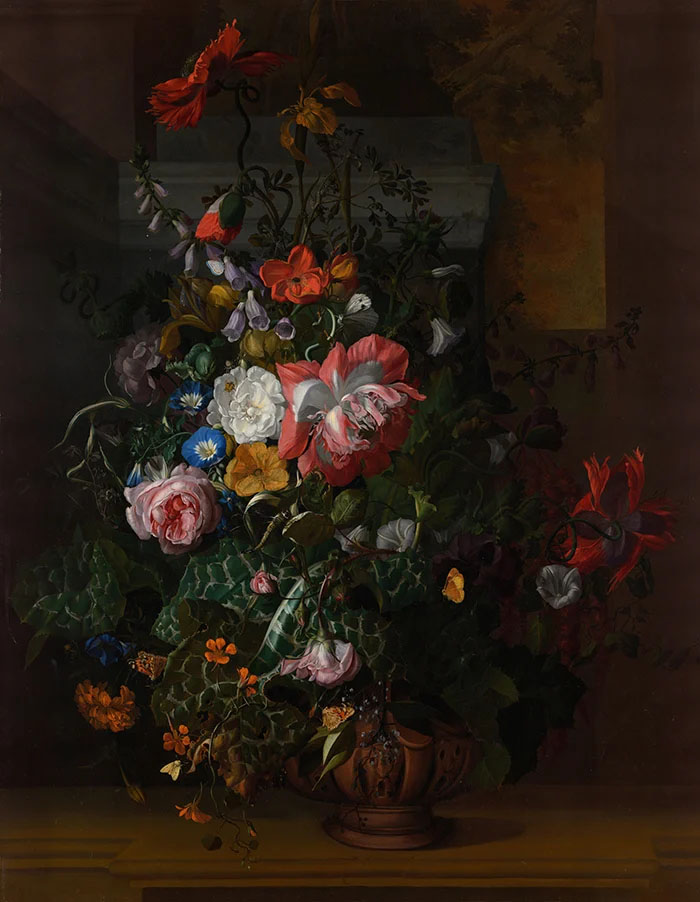
Jean-Baptiste-Simeon Chardin (1699 - 1779)
Chardin's paintings of still life depict simple objects and food. Unlike other still-life painters, Chardin chose his subjects from the home based on material quality and not their symbolic meaning. In the 19th century, his skill in recording objects was praised: ".. perhaps never has the material fascination for painting objects with no intrinsic value, transfiguring them through the magic of handling, been so developed ..."
Chardin's work was lauded by Academy members during his lifetime. As the trend shifted to historic paintings, Chardin's art became less popular. The artist's style is evident in this painting, which depicts a raw piece of meat on a metal hook alongside other kitchen tools. The leek and garlic are depicted with a great deal of realism. The reflection of the light on the bowl and jar catches our attention, as does a white piece of fabric on the left-hand side of the painting.
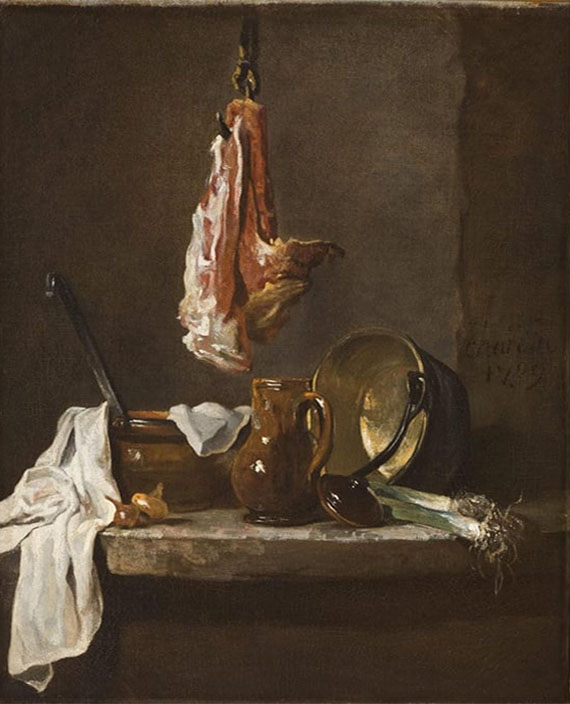
Luis Melendez (1716 - 1780)
Melendez's hyperrealistic still-life paintings depict the daily lives of Madrid's middle class in the 18th century. His compositions include a variety of foods, drinks, kitchen tools, and vessels. The artist didn't work with complete sets. He studied each object and painted it one by one, starting from the front to finish with the tabletop.
This artwork, which features a melon and pears next to kitchen utensils painted in a sober but sensuous manner, shows the artist's understanding of this genre. Scholars think this still life is from Melendez's series of "every type of food produced in Spain", which he created for the summer house of the King.
Ironically, these paintings were created during a period of severe food shortages. The artist had no money and once claimed his brush was all he owned.
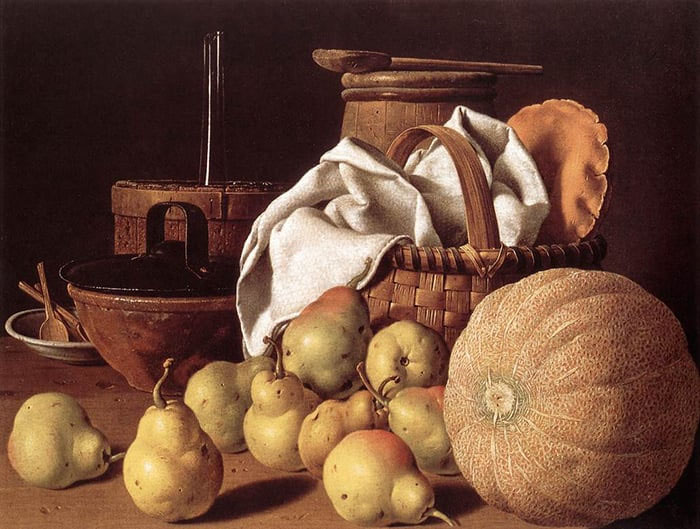
Francisco Goya (1746 - 1828)
Francisco de Goya introduced political and psychological themes into his dramatic compositions. His expressive paintings influenced future art movements. Goya painted at a rapid pace, but he only produced a few dozen still-lifes in his 60s. He then focused on painting private works in solitude.
One of the best-known is A Still Life with Golden Bream. This painting, illuminated by the moonlight, shows the beauty of fish and the death of those animals. The painting is mysterious, masterfully demonstrating the dying process. The fishes' unsteady arrangement gives the composition a dramatic feel. Some people have said that the scene is a symbol of the slaughter of humans during Spain's war with France.
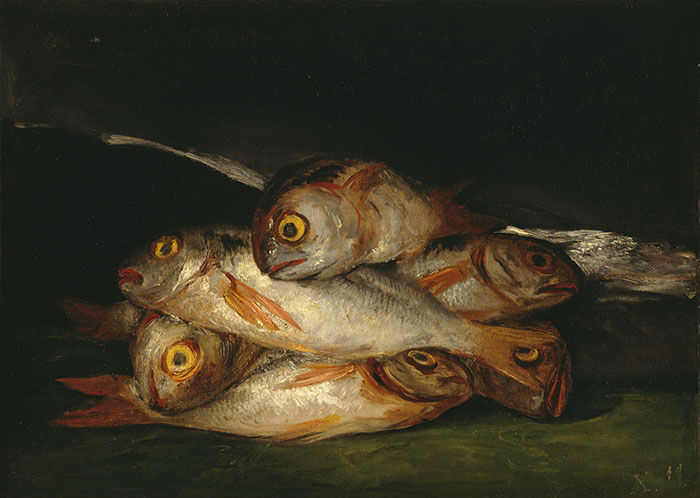
Sarah Miriam Peale (1860-1885)
Sarah Miriam Peale was part of the first American artistic dynasty, with her father, James Peale, and uncle, Charles Willson PeBoth. Her father and uncle trained Sarah. She specialized in miniature portraits but also painted realistic scenes of still life. Sarah, with her sister Anna Claypoole Peale (a miniaturist), were the first women to be elected into the Pennsylvania Academicians.
This group of artists is active at the Pennsylvania Academy of the Fine Arts. Sarah's skill is reflected in this still-life, entitled Peaches and Grapes, depicted in a porcelain dish. Notably, all the grapes have been depicted as perfect and not in decay. This was common for the genre. The light is focused on the grapes resting on the table and the peaches in the bowl. Both have complex patterns and textures.
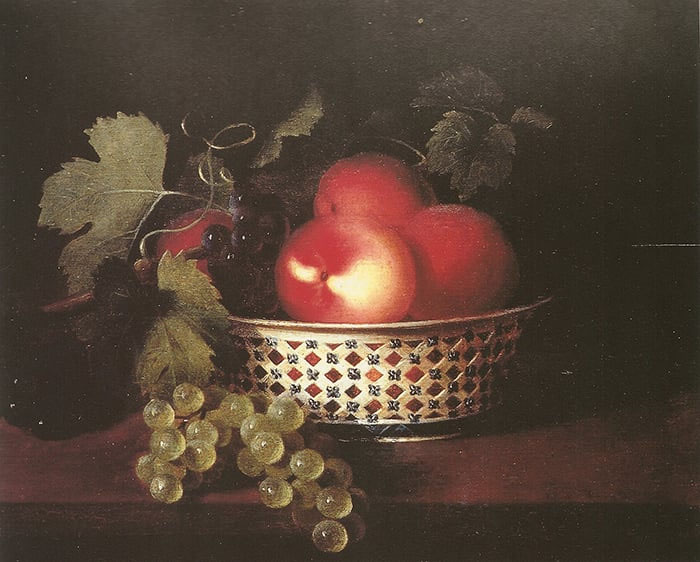
Gustave Courbet (1819 - 1877)
Courbet is considered the most prominent representative of Realism. Courbet was not only an artist but also a political activist who served time in jail for his subversive views. This still-life painting depicts a bowl of apples during the artist's imprisonment for his participation in the Paris Commune. The radical government which briefly ruled Paris was responsible for this work. He was allowed to use live models, but not while in prison.
Courbet's sister gave him flowers and fruit, and he began to explore still life, which he had previously neglected. In contrast to Dutch still-life paintings, in which fruits and flowers represent the passing of time, here, the apples are ripe.
The composition is filled with dim light. This comes from the dark place where the artist took this picture. The artist's tendency for paintings with deep shadows is clear in the artwork.
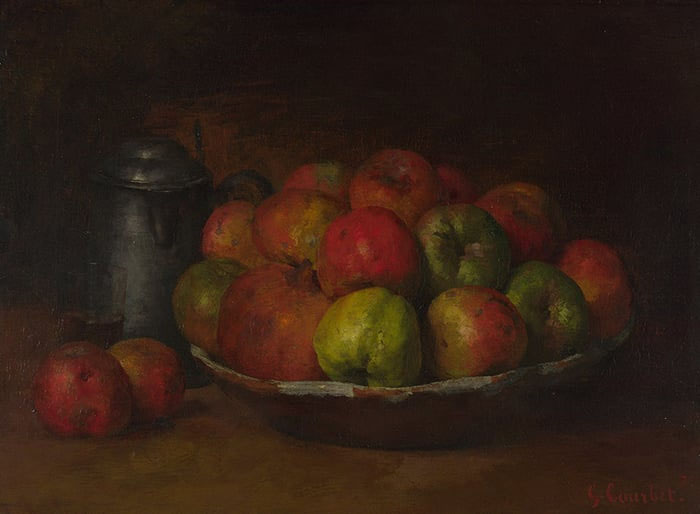
Lilly Martin Spencer (1822 - 1900)
Lilly Martin Spencer grew up in an environment that celebrated the talents of women. Spencer is renowned for her portrayals of American household scenes during the 1850s. Additionally, she was adept at crafting still-life artworks. Through her artistic endeavors, she managed to sustain a family comprising eight children.
Despite being wedded, Lilly pursued her academic aspirations, attending evening sketching sessions at the National Academy of Design. She was also conferred an honorary academy membership, a prestigious recognition for females of that era.
In the artwork titled "Fruits and Seeds," the artist's expertise in sketching and painting shines through. It features a vessel brimming with assorted fruits and seeds. While the oranges appear pristine, the grapes show signs of withering, adding a touch of urgency to the piece.
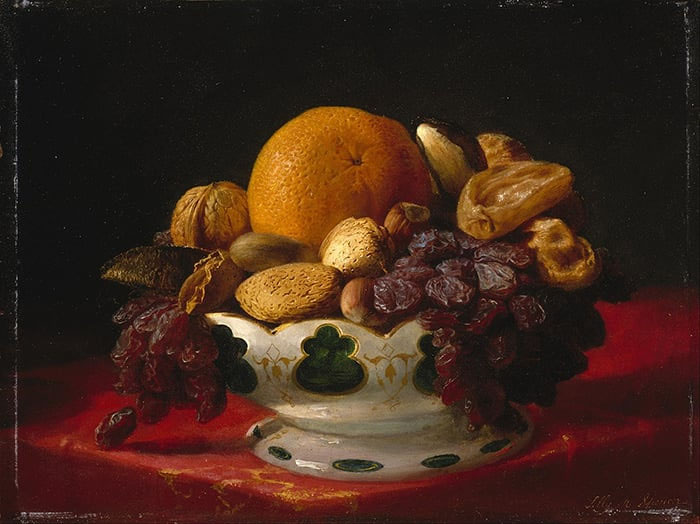
Henri Fantin Latour (1836 - 1904)
Henri Fantin Latour, a confidant of Manet, existed during the onset of Impressionism. Yet, he stayed true to Courbet's Realist ethos. Like his mentor Courbet, he felt that artworks should mirror reality, not conjure fantastical images. He also opined that hues resonated with poetry, and he aspired for his artworks to resonate like a melody.
Henri's philosophies are evident in his numerous still-life pieces, which constituted his primary earnings. One such artwork is replete with geometric figures and natural shapes, culminating in a serene arrangement of a floral vase, a dish of pears, and a cluster of pomegranates. The congruence in color schemes across these elements ensures a cohesive and balanced visual.
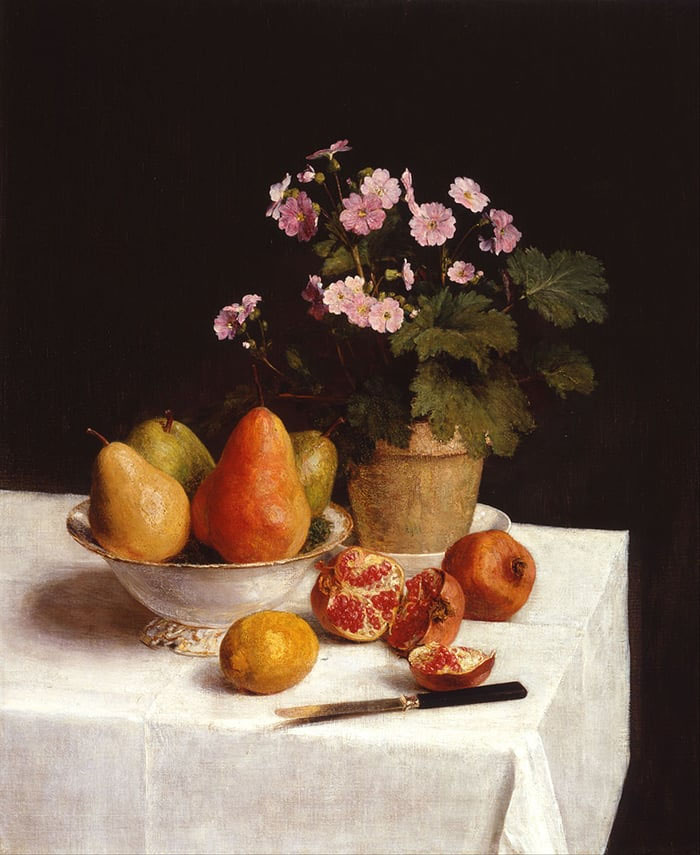
Paul Cezanne (1839 - 1906)
Paul Cezanne was a pioneer of modern art movements. Cezanne began to experiment with still-life paintings. The artist rearranged objects in his studio and played with different viewpoints. Cezanne's paintings often feature fruit that was freshly picked. He also liked to paint small sculptures, furniture, and household items. In the painting Apples and Peaches, we can see this.
Cezanne's words, "they (fruits) love having their portraits made", come to life when looking at the painting. They send their message through their scent. You can smell their scents as they tell you of the fields they have left behind, the rains that made them grow, and the dawns they witnessed..."
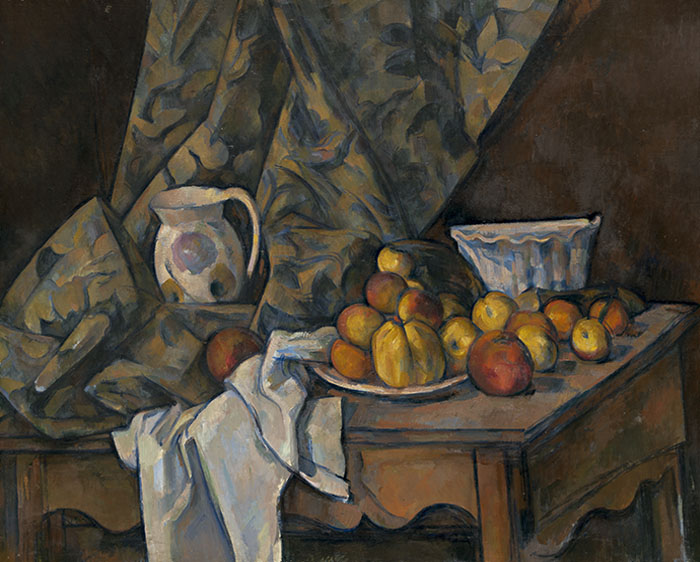
The Key Takeaways
-
In Flanders and the Netherlands, still-life paintings began to flourish in the 1600s. This is why many artists on this list hail from these areas.
-
Over the years, still-life paintings have been associated with religious symbolism. They are divided into sub-genres such as fruit and vegetable studies and meal still-lifes.
-
Vanitas paintings were very popular during the Dutch Golden Age of the 17th century. They contain collections of symbols that show the inevitable death of man and the fleeting nature of pleasures.
-
Memento Mori (a Latin phrase that means 'remember to die') still-lifes are linked to Vanitas, as they remind the viewer of their shortness through symbols such as skulls and extinguished candles.
-
Women who worked in this genre during their lifetimes were acknowledged. This is because this genre was considered more suitable for women.
-
Artists experimented over time with the genre, creating compositions about daily life habits rather than religious meanings. The genre was also reinterpreted in the 20th Century.
-
You can improve your art potential by painting still lifes.
No Comments Yet...